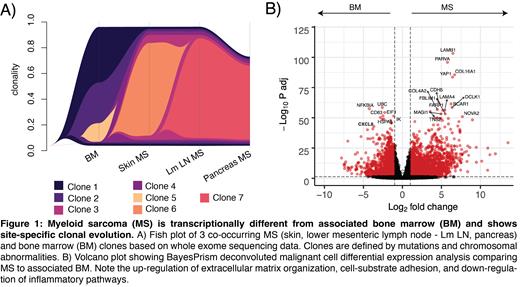Background: Myeloid sarcoma (MS) is a distinct form of acute myeloid leukemia (AML) found in ~10% of patients, in which mass-forming myeloid blasts proliferate in extramedullary sites. MS may present as an isolated lesion as the primary manifestation of disease, co-occur with AML, or, more commonly, arise in the setting of AML relapse. It is associated with poor outcomes, and treatment options are sparse. While increased knowledge of AML and its biology have improved the care and survival of AML patients, those with MS continue to have limited successful treatment options, as MS has typically not been included in AML genetic and genomic profiling efforts, and patients are excluded from clinical trials. Leukemia cutis (LC) is a form of extramedullary AML characterized by cutaneous involvement, often with an infiltrative and non-mass forming pattern of growth. Still, historically the literature has not made a clear distinction between MS and LC. Although recent small pilot studies have suggested differences in AML-associated mutations between medullary AML and MS, knowledge of the complete molecular and cellular composition of MS and comprehensive comparison with AML is lacking. While molecular characterization of the extramedullary disease site is encouraged in the updated clinical recommendations, no definitive guidance exists for changes in the management and care of AML patients with MS, given the substantial gap in our current knowledge and understanding of extramedullary AML.
Methods: Here, we performed RNA-Seq (n=96), single-cell (sc) RNA-Seq (n=33), and mutation profiling using either whole exome sequencing (WES, n=6) or a 409-gene targeted sequencing panel (n=48) of MS or LC patient samples and bone marrow (BM) aspirates from AML patients with and without extramedullary disease to present the first comprehensive characterization of MS and LC.
Results: Our WES data showed thatMS and LC evolve independently in the extramedullary site from concurrent medullary disease with distinct dominant clones, characterized by higher median tumor mutation burden (1.66 vs. 064 mutations per megabase, respectively; p=0.0059) and increased copy number aberrations, which both validated in an MS Tet2 HR mouse model. Notably, we observed location-specific molecular evolution in patients with multiple concurrent MS sites (Figure 1A) and patients with recurring MS in WES and targeted panel data. While targetable mutations (i.e., IDH1/2 mutations and FLT3-ITD/TKD) occur, the inter-site variability of molecular aberrations may explain the short-lived responses of AML patients with MS to IDH/FLT3 inhibitors. Transcriptional profile differences between MS and associated medullary disease included up-regulation of extracellular matrix organization and cell-substrate adhesion and down-regulation of inflammatory response pathways in both bulk and scRNA-seq data (Figure 1B). Further, involved BM malignant cells of MS patients compared to patients without MS up-regulated specific pathways, including interferon-gamma response observed in both bulk and scRNA-seq, as well as chromatin organization and splicing. We further revealed that MS patients without overt BM involvement show remodeling of the BM immune microenvironment, with increased fractions of hematopoietic stem and progenitor cells that down-regulate HLA class II genes. Comparing LC and MS in the skin revealed distinct differences in their expression profiles, including high expression of genes involved in cell migration and immune response in LC, suggesting LC and MS represent distinct disease entities. Lastly, we demonstrated high expression of BCL2 in extramedullary disease (p=0.0074) and presented initial evidence that treatment with BH3-mimetics may be beneficial for the treatment of isolated MS.
Conclusions: Myeloid sarcoma shows distinct molecular evolution and microenvironmental composition compared to medullary disease, including location-specific evolution necessitating personalized management consideration. Leukemia cutis is distinct from MS tumorous lesions and should be considered a separate entity. High BCL2 expression in extramedullary disease might represent a promising targetable vulnerability in patients with isolated MS.
Disclosures
Loghavi:Caris Diagnostics: Consultancy; Blueprint Medicine: Consultancy; Abbvie: Consultancy; Gerson Lehrman Group: Consultancy; QualWorld: Consultancy; Guidepoint: Consultancy; Recordati/ EUSA Pharma: Consultancy; Daiichi Sankyo: Consultancy; Astellas: Research Funding; Amgen: Research Funding; Abbvie: Current equity holder in publicly-traded company. Walker:Karyopharm Therapeutics Inc.: Consultancy, Current Employment, Current equity holder in publicly-traded company. Kaffenberger:Novartis: Consultancy; Merck: Current Employment; BMS: Current Employment; ADC Therapeutics: Consultancy; Biogen: Consultancy, Current Employment. Guillamot Ruano:Loxo Oncology: Current Employment. Yeaton:Immunai: Current Employment. Pollyea:AbbVie: Consultancy, Research Funding; Aptevo: Consultancy; Arcellx: Consultancy; AstraZeneca: Consultancy; BeiGene: Consultancy; BerGen Bio: Consultancy; Bristol-Myers Squibb: Consultancy, Research Funding; Genentech: Consultancy; Glycomimetics: Consultancy; Hibercell: Consultancy; Immunogen: Consultancy; Jazz: Consultancy; Kura: Consultancy; LINK: Consultancy; Magenta: Consultancy; Medivir: Consultancy; Novartis: Consultancy; Qihan: Consultancy; Ryvu: Consultancy; Syros: Consultancy; Zentalis: Consultancy; Karyopharm: Research Funding; Teva: Research Funding. McMahon:Syndax Pharmaceuticals: Research Funding; Arcellx: Membership on an entity's Board of Directors or advisory committees; Syros Pharmaceuticals: Research Funding; Kura Oncology: Membership on an entity's Board of Directors or advisory committees. Byrd:Newave: Membership on an entity's Board of Directors or advisory committees, Research Funding; Kurome: Current equity holder in publicly-traded company, Membership on an entity's Board of Directors or advisory committees; Vincerx: Current equity holder in publicly-traded company, Membership on an entity's Board of Directors or advisory committees; OSU Drug Devel. Inst.: Consultancy; Orbimed: Consultancy, Research Funding; Eilean Therapeutics: Consultancy, Current equity holder in private company, Membership on an entity's Board of Directors or advisory committees, Research Funding; Orange Grove Bio: Membership on an entity's Board of Directors or advisory committees; American Cancer: Membership on an entity's Board of Directors or advisory committees; AstraZeneca: Other: TRAVEL, ACCOMMODATIONS, EXPENSES. Mims:Jazz Pharmaceuticals: Membership on an entity's Board of Directors or advisory committees. Eisfeld:Karyopharm Therapeutics: Other: spouse employment; Astra Zeneca: Honoraria, Other: CEI Advisory Board; OncLive: Honoraria.


This feature is available to Subscribers Only
Sign In or Create an Account Close Modal